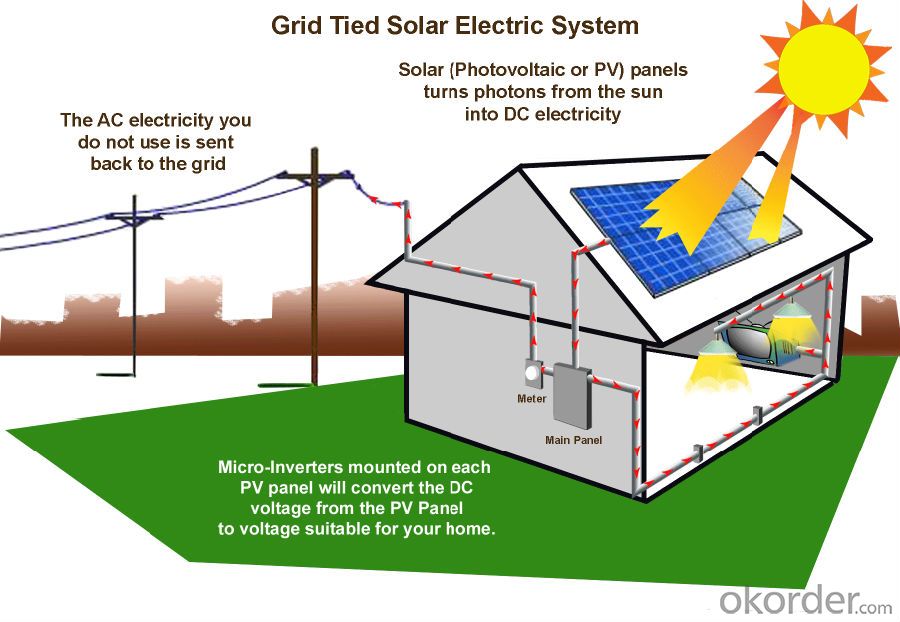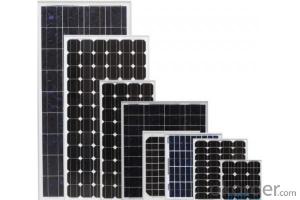Solar Panel Solar Module PV Solar With A Grade 180W
- Loading Port:
- Shanghai
- Payment Terms:
- TT OR LC
- Min Order Qty:
- 1 watt
- Supply Capability:
- 10000000 watt/month
OKorder Service Pledge
OKorder Financial Service
You Might Also Like
Item specifice
Solar panel material
1. glass
Its main role is to protect the power generation ( solar cells ) , there is a selection of light transmittance requirements : 1 ) must be high transmittance (typically 91% or more ) ; 2 ) super white steel processing.
2. EVA
For bonding glass and power generation fixed body ( such as cells ) , transparent EVA material directly affect the life of components exposed to the air EVA prone aging yellow , thus affecting the transmittance components , thus affecting in addition to generating the quality of the components itself, the quality EVA lamination process on the component manufacturers is also very large, such as EVA plastic viscosity of non-compliance , EVA and glass, back bonding strength is not enough, can cause premature aging EVA, the affected component life.
3. Solar cells
The main role is to generate electricity , the electricity is the main market mainstream film crystalline silicon solar cells , thin-film solar cells , both have their advantages and disadvantages . Crystalline silicon solar cells , the equipment costs are relatively low , but the high cost of consumption and cells , photoelectric conversion efficiency is high, the next generation in outdoor sunlight is more appropriate ; higher thin-film solar cells , the relative cost of equipment , but the cost of consumption and battery low, relatively low photoelectric conversion efficiency of crystalline silicon solar cells , but the effect is very good low-light , in the ordinary light can also generate electricity , such as solar calculator .
4. backplane
Sealing, insulation , water ( usually with TPT, TPE , etc. ) the material must be resistant to aging , component manufacturers generally have warranty for 25 years , tempered glass, aluminum is generally no problem , the key lies in whether the backplane and can meet the requirements of silica gel.

PERFORMANCE
- High effi ciency, multicrystalline silicon solar cells with high transmission and textured glass deliver a module effi ciency of up to 16.0%,
minimizing installation costs and maximizing the kWh output of your system per unit area.
- Tight positive power tolerance of 0W to +5W ensures you receive modules at or above nameplate power and contributes to minimizing
module mismatch losses leading to improved system yield.
- Q:I am interested in solar energy, but am not sure how eficiant it would be in the northwest? Any comments would be apriciated.
- Are solar panels a good thing to do for the environment? - Yes. Can you recoup the cost your investment in the solar cells/panels in any reasonable amount of time in Seattle? - most likely - not. I know it's been a miserable spring in Seattle, but, I think we got 3 sunny days last month. With the number of cloudy/rainy days here, solar will only really benefit you in June, July, August and September. There are two kinds of solar panels - electric or water based. The electrics - photovoltaics - are costly to purchase and it's difficult to store the electricity once you make it. A water heater type solar panel initially cost less and can provide some benefit even on partly cloudy days. I have even seen instructions on how to build your own (if you are frugal and handy) I just do not think it's worthwhile in Seattle - if it was Denver or Phoenix we were talking about - then it would be a different story.
- Q:I was thinking of having some installed on our rooftop and was wondering if it would be worth the cost? The house is located in Sac, Cali. The panels would face the sun 2 months out of the year and in the summer roughly 4 hours of straight sun.
- You can log in alibaba,i purchased about 20000watts 2 years ago and solar panels work efficiency is fairly high. I hope my answer help you !
- Q:Can solar panels be used to power a shopping mall?
- Yes, solar panels can be used to power a shopping mall. By installing a sufficient number of solar panels on the mall's rooftop or in nearby areas, it is possible to generate enough electricity to meet a significant portion of the mall's power requirements. This can help reduce the mall's reliance on traditional grid electricity and promote the use of clean, renewable energy sources.
- Q:Okay so.. if light deflect the light of the sun and black absorbs it, then aren't solar panels just absorbing more light, sun and heat into our atmosphere? Wouldn't this lead to an increase in global warming? Shouldn't solar panals be white? No rude answers please.
- There are two basic types of solar panels. ) Thermal absorbers 2) Photovoltaics Thermal absorbers are black in order to convert sunlight to thermal (heat) energy. The whole idea is to capture all of the light with a dark surface, convert it to thermal energy and transfer the energy into your home for water heating or space heating. If you make the surface white or reflective, then the surface will absorb only a small fraction of the available light, hence the efficiency will be very low. In other words, the panel will not produce any heat. Photovoltaic panels produce electricity instead of heat energy. Photovoltaic panels are made from thin slices (“waffers”) of silicon with special coatings on the front and back surface. One of these coatings on the front is an antireflection coating to capture the light and channel it toward the silicon. Underneath the antireflection coating the silicon waffer is coated with other chemicals that convert the sunlight to electricity. The combination of these coatings gives the panel a dark color, usually blue or black. Here's the bottom line. If you want thermal heat or electricity from solar panels, the panels have to capture the light. When that light is captured, the surface appears dark because no light (or very little) light is reflected back to our eyes. It is not possible for a surface to be an efficient absorber, capturing all available light, and at the same time appear white or bright color or reflective to our eyes.
- Q:what are the main minerals that are used in making solar panels. and where in the world are those minrelas usually found
- Heating panels have aluminum for the frame, glass for the top, copper pipes running through them, and possibly some plastic parts. The raw materials are easily obtained. Copper is the most difficult to get probably, but it's not all that rare, since we used to make pennies out of it. A solar electric panel is similar, with the copper used for wires and interconnect instead of pipes. The actual solar cells commonly used are almost completely pure silicon, which is abundant worldwide. There are traces of other elements in the silicon like boron, arsenic or phosphorous - these are also inexpensive, and easy to get.
- Q:If a solar panel has a power rate of 80 Watts and efficiency of lets say 30%. Does that mean the maximum power this solar panel can generate is (30/00)*80=54 Watts or its just 80 Watts?
- Solar panels are tested in a lab that has a light the produces 000 watt/hrs per square meter. In these conditions your panel will produce 80 watt/hrs. If you would like to know what it does in really world conditions you have to find the sun-hours in your given area. A sun-hour is basically how many watt/hrs hit a square meter in a day. This number changes based on time of year, orientation, and temperature. Here in Fairbanks Alaska if the panel was at 90 degrees facing true south in October (.9 sun-hours) It would produce 80 X .9 X .8 (20% efficiency loss due to wires and controllers) it would produce 273.6 watt/hrs on average each day.
- Q:planning to get one, for a store/house, we use alot of electricity at least 500-3000 dollars a month. how much money would this save us? how big would we have to get the solar panel?[aproximately]
- Consider installing building energy measurement first, which cost less than $200. Work out what is using the energy and if there are more efficient options. Consider co-generation which uses gas for an energy input and electricity generation and heat as an output. Use the Solar Energy Calculator to work out how much solar panel area is needed to generate the remaining power needed in you are of the world.
- Q:Why are they placed there? How come they aren't placed on the floor or window.My fiance and I are interested in putting solar panels on our new home. I was really curious and google wasn't giving me the answer. My roof is pretty small in our new house and I don't think it would fit there. Why is it usually placed there and is there another place? You will be chosen as best answer if you answer all my questions. Thanks in advance, and I would appreciate if nobody is rude. Otherwise, I will have to report abuse.
- The roof receives the most direct sunlight, and the more direct the sunlight the more electricity is produced. I've never seen solar panels located elsewhere on a house, but I have seen some placed in a yard or field.
- Q:Are solar panels suitable for all climates?
- Solar panels are suitable for most climates, but their efficiency may vary depending on factors such as sunlight intensity, temperature, and weather conditions. While solar panels can generate electricity in cloudy or colder regions, they are most efficient in areas with abundant sunlight and moderate temperatures. Advances in technology have made solar panels more adaptable to different climates, allowing for their effective use in various regions around the world.
- Q:Can solar panels be used in areas with high levels of dust or sandstorms?
- Yes, solar panels can be used in areas with high levels of dust or sandstorms. However, frequent and heavy exposure to dust or sand can reduce their efficiency over time. Regular cleaning and maintenance are necessary to ensure optimal performance in such areas. Additionally, advanced solar panel designs and coatings are being developed to mitigate the impact of dust and sand accumulation, making them more suitable for use in these challenging environments.
1. Manufacturer Overview |
|
|---|---|
| Location | |
| Year Established | |
| Annual Output Value | |
| Main Markets | |
| Company Certifications | |
2. Manufacturer Certificates |
|
|---|---|
| a) Certification Name | |
| Range | |
| Reference | |
| Validity Period | |
3. Manufacturer Capability |
|
|---|---|
| a)Trade Capacity | |
| Nearest Port | |
| Export Percentage | |
| No.of Employees in Trade Department | |
| Language Spoken: | |
| b)Factory Information | |
| Factory Size: | |
| No. of Production Lines | |
| Contract Manufacturing | |
| Product Price Range | |
Send your message to us
Solar Panel Solar Module PV Solar With A Grade 180W
- Loading Port:
- Shanghai
- Payment Terms:
- TT OR LC
- Min Order Qty:
- 1 watt
- Supply Capability:
- 10000000 watt/month
OKorder Service Pledge
OKorder Financial Service
Similar products
New products
Hot products
Hot Searches
Related keywords




























